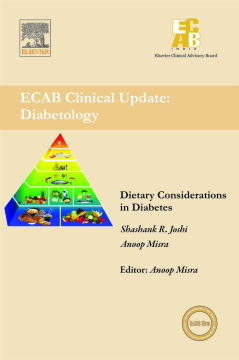
Additional Information
Book Details
Abstract
Diet plays an important role in the treatment of diabetes, alone or in combination with insulin or oral hypoglycemic drugs. The diabetic nutrition plan of an individual necessitates to be based upon, excepting the usual parameters, his/her socioeconomic status, ethnicity/religion, and local food habits. It is important that diet plan is individualized and also region based. Since there are a number of artificial sweeteners available now, it is necessary that physicians should take in account scientific data while prescribing any artificial sweetener. This issue in the ECAB Update Series: Diabetology reviews these issues in accordance with the Indian Dietary habits and available evidence to support the clinical decisions.
Table of Contents
| Section Title | Page | Action | Price |
|---|---|---|---|
| Front Cover | Front Cover | ||
| Front Matter | ia | ||
| ECAB Clinical Update:Diabetology | ic | ||
| Copyright | ie | ||
| About the Authors | if | ||
| Contents | ig | ||
| ECAB Clinical Update InformationDietary Considerations in Diabetes | i | ||
| Introduction | 1 | ||
| Micronutrients and Diabetes | 3a | ||
| Abstract | 3a | ||
| Keywords | 3a | ||
| Micronutrients | 3a | ||
| Role of Micronutrients in Noncommunicable Diseases in the Developing Countries | 4 | ||
| Increased Oxidative Stress in Diabetes | 6 | ||
| Micronutrients and Indian Diets: Composition and Absorption | 6 | ||
| Adolescents and Young Adults | 7 | ||
| Pregnant Women | 7 | ||
| Urban Slum Population | 7 | ||
| Chromium (Cr) | 8 | ||
| Chromium in Glucose Metabolism | 8 | ||
| Mechanism of Action | 8 | ||
| Chromium and Diabetes: Research Findings | 9 | ||
| Deficiency | 10 | ||
| Toxicity | 10 | ||
| Diet Recommendations | 10 | ||
| Food Sources | 11 | ||
| Supplements | 11 | ||
| Indian Update | 12 | ||
| Magnesium (Mg) | 12 | ||
| Mechanism of Action | 13 | ||
| Magnesium and Diabetes: Research Findings | 13 | ||
| Deficiency | 15 | ||
| Toxicity | 16 | ||
| Diet Recommendations | 16 | ||
| Food Sources | 16 | ||
| Supplements | 16 | ||
| Zinc (Zn) | 16 | ||
| Mechanism of Action | 17 | ||
| Zinc and Diabetes: Research Findings | 18 | ||
| Cochrane Review on Micronutrient Zinc | 18 | ||
| Deficiency | 19 | ||
| Diet Recommendations | 19 | ||
| Food Sources | 19 | ||
| Indian Update | 19 | ||
| Vanadium (V) | 20 | ||
| Mechanism of Action | 20 | ||
| Vanadium and Diabetes: Research Findings | 21 | ||
| Toxicity | 22 | ||
| Diet Recommendations | 22 | ||
| Food Sources | 23 | ||
| Selenium (Se) | 23 | ||
| Mechanism of Action | 23 | ||
| Selenium and Diabetes: Research Findings | 23 | ||
| Toxicity | 24 | ||
| Diet Recommendations | 25 | ||
| Food Sources | 25 | ||
| Micronutrients in Other Conditions | 25 | ||
| Malabsorption | 25 | ||
| Pregnancy and Lactation | 27 | ||
| Elderly Population | 27 | ||
| Fortification and Supplementation With Essential Micronutrients | 32 | ||
| Tackling Obstacles | 34 | ||
| Conclusion | 35 | ||
| DefinitionsiiSource: Institute of Medicine, Food and Nutrition Board. | 36 | ||
| Artificial Sweeteners | 44a | ||
| Abstract | 44a | ||
| Keywords | 44a | ||
| Current Indian Scenario | 47 | ||
| Reasons to Use Artificial Sweeteners | 47 | ||
| Global Update | 49 | ||
| Non-nutritive Sweeteners | 50 | ||
| Saccharin | 50 | ||
| Aspartame | 52 | ||
| Sucralose | 55 | ||
| Acesulfame-K (Potassium) | 57 | ||
| Herbal Sweeteners | 59 | ||
| Other Sweeteners | 60 | ||
| Neotame | 60 | ||
| Alitame (Alclame) | 60 | ||
| Cyclamate | 60 | ||
| Sugar Alcohols (Reduced Calorie Sweeteners) | 63 | ||
| Fructofibers | 63 | ||
| Indian Scenario | 64 | ||
| Indian Market | 65 | ||
| Sugar-Free Products in Indian Market | 66 | ||
| Conclusion | 70 | ||
| Frequently Asked Questions | 71 | ||
| Region-based Dietsin India | 75a | ||
| INTRODUCTION | 75a | ||
| EPIDEMIOLOGY | 76 | ||
| CLASSIFICATION | 77 | ||
| DIET PATTERN IN DIFFERENT ZONES ANDCOMMUNITIES | 78 | ||
| IDEAL DIABETIC DIET (ZONE- WISE) | 85 | ||
| 1) West Zone Diet | 85 | ||
| 2) East Zone Diet | 86 | ||
| 3) South Zone Diet | 87 | ||
| 4) North Zone Diet | 87 | ||
| DIET PLANNING FORINDIAN DIABETIC PATIENTS | 88 | ||
| Type of Carbohydrate and Amount of Fiber | 88 | ||
| SAMPLE DIET PLAN FORNON-INSULIN-DEPENDENT DIABETES MELLITUS | 88 | ||
| SAMPLE DIET PLAN FOR INSULIN-DEPENDENTDIABETES MELLITUS | 89 | ||
| FOODS TO BE AVOIDED IN A DIABETICPATIENT | 89 | ||
| FOODS TO BE RESTRICTED IN A DIABETICPATIENT | 89 | ||
| FOODS TO BE USED FREELY IN DIABETICPATIENTS | 90 | ||
| Summary | 91 | ||
| Forthcoming Books | 93 |
